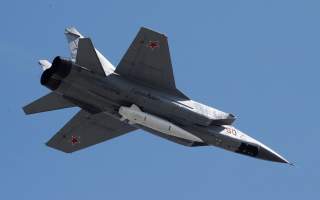Could Russia's MiG-31 Shoot Down Satellites and Fight in the Stratosphere?
Very ambitious plans.
Key point: Russia's MiG-31 is an impressive plane that looks set to only get better. But can Moscow create all the new technologies it wants?
From mounting hypersonic Kinzhal missiles to deploying anti-satellite technology, the Russian Air Force has big plans for their MiG-31 fighter.
Recently released exercise footage of MiG-31’s intercepting an “intruder” in the stratosphere sheds further light on the capabilities and intended role of its latest incarnation, the MiG-31BM.
The clip, released by the Russian Ministry of Defense, depicts a typical home defense scenario. An older MiG-31 variant played the role of a surveillance aircraft collecting data in Russian airspace. Two 31BM’s were then dispatched to intercept the intruder after being alerted to its presence by ground-based radar systems. The 31BM’s located and successfully targeted the intruder with “mock air-to-air missiles” at a distance of 150 km.
This is standard fare for jet fighter drills, save for one remarkable detail: the exercise took place in the stratosphere, with the intercepting MiG-31BM’s flying at supersonic speeds. “The crews have flown at supersonic speeds of over 2,800 km/h at the altitude of 18,000 meters,” according to Ministry of Defense press statement.
Russian state news outlet TASS reports that the exercise involved ten crews, suggesting multiple, rotating sets of interceptors and intruders. Given that the 31BM is the latest variant in the prolific MiG-31 line, these kinds of exercises are as much intended to test new hardware as they are to train pilots in using it.
As previously highlighted by The National Interest, the MiG-31’s ability to deliver heavy payloads at such impressive heights and speeds explains why it is currently the only Russian jet fighter cleared to be serially outfitted with Kinzhal hypersonic missiles. A 12 to 16-unit squadron of Kinzhal-armed MiG-31’s was deployed around the Black Sea region in mid-2018, after several rounds of combat testing in the prior months.
But while the strategic threat capability of the MiG-31 has been well covered over the past year, this recent exercise is a reminder of the MiG-31’s tactical utility as an interceptor. The 31BM retains the DNA of its distant, Soviet MiG-25 predecessor in its ability to effectively engage fast, high-flying surveillance planes like the SR-71 Blackbird.
From its inception in the early 1980’s through to the present day, the MiG-31 has been the fastest aircraft to serve in the formerly Soviet and now Russian Air Force. Its speed makes it especially well-suited as a home-defense interceptor, capable of zipping through Russia’s vast airspace to locate and engage intruders as quickly as possible.
The 31BM upgrade of 2010 follows the established Russian trend of preserving original aircraft designs while integrating modern weapons and avionics. These include digitized controls, a new LCD display, and an updated Zaslon-M radar capable of tracking up to ten airborne targets simultaneously. The MiG-31BM uses the same efficient, albeit aging, D-30F6 engine as the original MiG-31.
If these minor quality-of-life updates sound unexciting, that’s because the the major hardware revamp is being saved for the upcoming MiG-41. Tentatively scheduled to enter production in the mid 2020’s at the earliest, the MiG-41 is expected to be a hypersonic jet capable of flying in outer space (327,000 feet).
Mark Episkopos is a frequent contributor to The National Interest and serves as a research assistant at the Center for the National Interest. Mark is also a Ph.D. student in History at American University. This article first appeared earlier in 2019.
Image: Reuters

